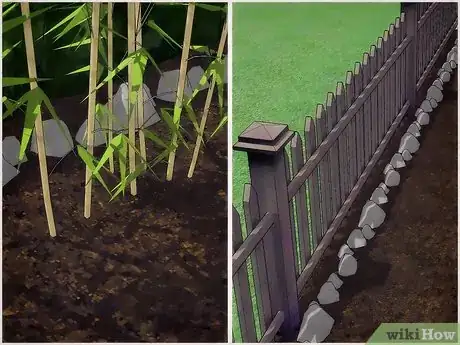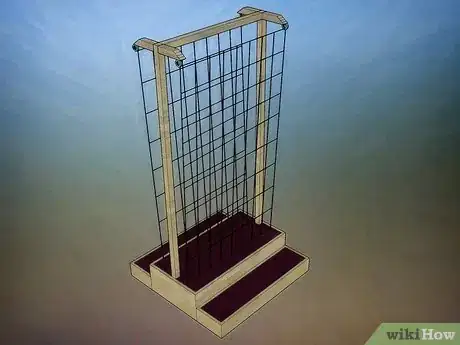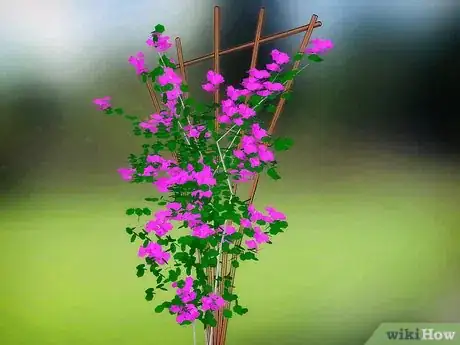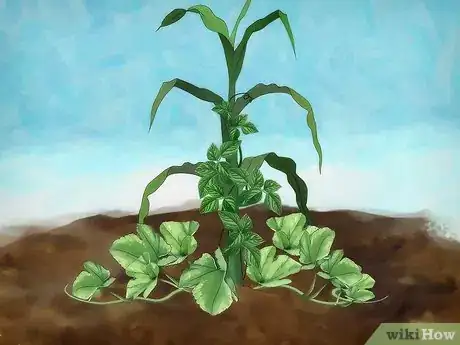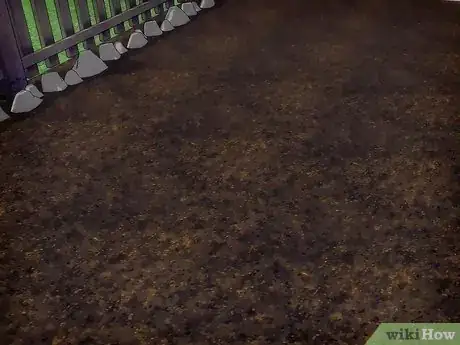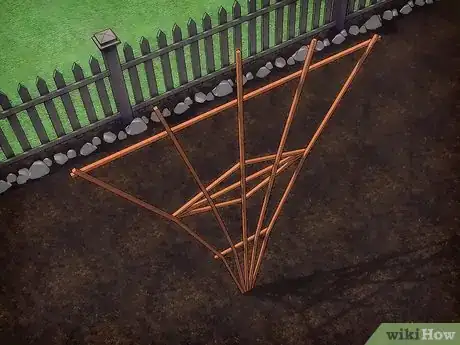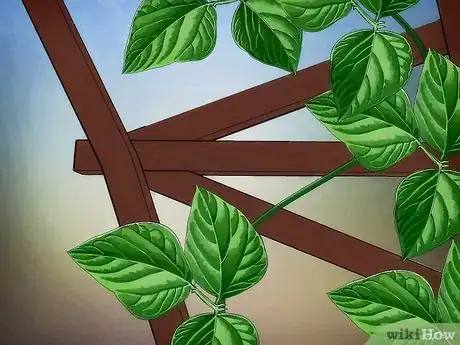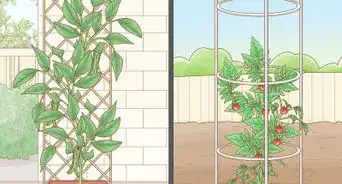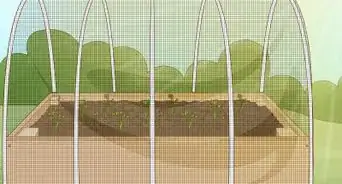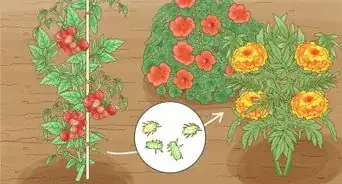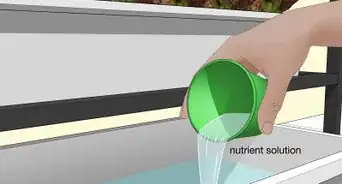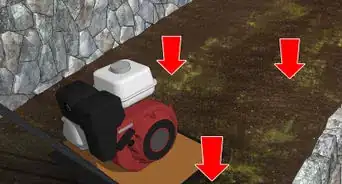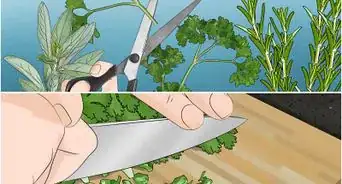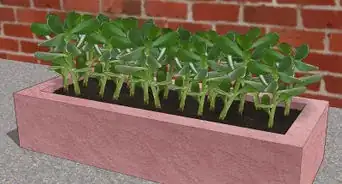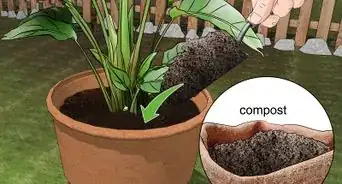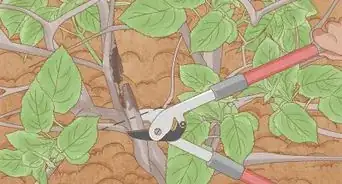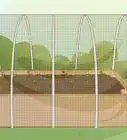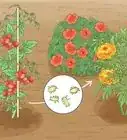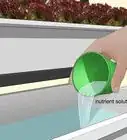This article was co-authored by Andrew Carberry, MPH. Andrew Carberry is a Food Systems Expert and the Senior Program Associate at the Wallace Centere at Winrock International in Little Rock, Arkansas. He has worked in food systems since 2008 and has experience working on farm-to-school projects, food safety programs, and working with local and state coalitions in Arkansas. He is a graduate of the College of William and Mary and holds a Masters degree in public health and nutrition from the University of Tennessee.
This article has been viewed 148,741 times.
If your horizontal garden space is limited, or you're interested in adding a new level of texture and beauty to your yard, consider building a vertical garden. Many plants naturally grow, vine-like, up trees and walls, and these can easily be trained to grow upward on the structure of your choice. Read on to find out how to start your vertical garden.
Steps
Choosing a Vertical Garden Structure
-
1Buy a garden structure from a garden store. Since vertical gardens are growing in popularity, home and garden stores increasingly carry a variety of structures suitable for building a vertical garden. Choose from among these options:
- Buy simple poles you can set into the ground. Metal poles are better if you have dense or clay soil because they can be driven through hard ground. If your ground is loose, wooden poles will be fine. Stick the poles every few feet along a row of plants. As the plants grow, run a line of garden twine down one side, loop around the far pole, and tie off at the end where you started. Tie the twine to each pole along the way to support plants.
- Buy a trellis. Trellises are often made of wood. They are built in the shape of a box with a cross-hatched top and sides, allowing vines and plants to weave themselves through the gaps in the wood.
-
2Use vertical features you already have. There's no need to go out of your way to buy a structure if you don't want to spend the money. You probably already have items you can use to grow a vertical garden. Consider the following:
- A tree. That's right, you can train a plant to grow around a tree. The best type of tree for this is one with branches that begin more than 6 feet (1.8 m) up the tree.
- Bamboo poles. Is there a stand of bamboo located near your home? Bamboo provides a sturdy base for a vertical garden, and it's often easy to get it for free. If you don't have bamboo, another strong, tall stick of some kind will do.
- Your deck. If you have a deck that extends several feet or yards above the ground, you can train plants to grow up the sides.
- A fence. Most any fence provides suitable structure for a vertical garden - the taller, the better!
Advertisement -
3Build your own vertical trellis. For a completely customized vertical garden structure, build your own out of wood. Building your own structure allows you to create a garden with the right dimensions for your yard. Here's a step-by-step guide for building a 6-foot high garden structure:
- Build a 2 foot (0.6 m) square by 11 inch (27.9 cm) high box from redwood, cedar, or pressure-treated 2 x 6s. Screw 8-foot pressure-treated 2 x 2s at the center and one corner in back, and 6-foot 2 x 2s at the other corner and 18 inches (45.7 cm) from the back on both sides.
- Pre-drill, glue and screw 1 x 2s every 6 inches (15.2 cm), starting at the top of the box. Extend the 1 x 2s at least an inch beyond each 2 x 2 to minimize the danger of splitting.
- Add platforms by screwing on 3-foot 1 x 2s, then screwing on 1 x 2s laid flat to create a miniature deck.
- Add one more 6-foot long 2 x 2 in the center at the front, and screw it to the crosspieces.
- Add a 1 x 4 crosspiece at the top of the two longest 2 x 2s. If you want, you can attach a bird house to the crosspiece.
- Fill the box with good soil, then plant climbing plants and train them up the lattice. Add other plants in pots and hanging baskets.
Choosing the Right Plants
-
1Grow vegetables vertically. Many types of vegetables and legumes grow on vines, making them great candidates for a vertical garden. Peas and beans naturally twist and curl over stakes and trellises, and many of them also produce pretty flowers in the spring. Here are a few ideas:
- Grow scarlet runner beans, which attract hummingbirds and have red and white blossoms.
- Go with tomatoes, which must grow vertically in order to stay healthy and produce a lot of fruit. Your summer will be filled with juicy red goodness.
- Some varieties of squash grow vertically, too. Try trombetta squash, which produces pretty flowers.
- Cucumbers also grow well on trellises.
- Hops, which are the essential ingredient in beer, grow at least 6 feet (1.8 m) into the sky.
-
2Create a vertical flower and vine garden. If you're keen on building a whimsical vertical garden - the kind you can stroll underneath with your sweetheart while you enjoy the fragrance of its flowers - look for flower and ivy varieties that prefer to grow toward the sky. Be sure to choose plants that do well in your particular region.
- Morning glories grow fast and strong, and they produce gorgeous flowers in many different hues.
- Wisteria, which blooms purple and produces a lovely scent, is a popular choice for vertical gardens.
- English ivy provides a pleasing green backdrop for more colorful flowers.
- Climbing roses will give your vertical garden a romantic touch.
-
3Plant the three sisters. For a completely natural vertical garden, you can't go wrong with the three sisters: beans, squash and corn. Native Americans planted these three vegetables together because they coexist so well with one another. They also make for a gorgeous natural vertical garden; the corn provides a "pole" for the beans while the squash will grow along the ground.
Starting the Garden
-
1Pick a good spot. A vertical garden, like any other type of garden, needs to be planted in an area with good soil drainage and the right combination of shade and sunlight. Figure out what conditions the plants you're growing need to thrive, then choose a suitable area in your yard or on your patio.
- Most vertical gardens do well with a lot of sunlight.
- Pick a spot close to a wall if you want your garden to eventually climb the walls of your house.
-
2Make sure the garden structure is stable. If you're using a trellis, a stake or a pole, be sure to bury it deep in the ground so that it doesn't wobble or fall over. Remember that the garden will get heavier as it grows, and it will need a solid foundation that can stand up to wind and rain.
- Use a post driver to push your metal or wooden posts deep into the ground.
-
3Plant around the base of the structure. Taking into account the individual needs of the plants you are using, plant seeds or seedlings in holes spaced around the base of the trellis, pole or other structure you are using. Make sure they aren't too close to each other or the structure so that they'll have room to root and grow.
-
4Care for the plants according to their needs. Make sure they get adequate water and that you fertilize them, protect them with mulch, and take other measures they need to grow healthy and strong.
-
5Train the plants. When the seedlings get a few inches high, it's time to train them to wrap around the structure you erected. Gently wrap the stems of the plants around the base of the structure, taking care not to bend or break them. Use ties to hold the stems in place as they grow.
- Don't tie the stems too tightly. This prevents them from growing properly and may actually damage the plant.
- As the stems begin to grow and wind around the structure, continue using ties to train them to grow in the direction you want them to grow.
- For vines like hops, tie a string to the trellis a few feet above the ground, and stake it to the ground near the plant. Train the plant up the string until it reaches the trellis. If you are using metal or other slick types of materials, run the string all the way to the top so the vines have something to grab onto.
Expert Q&A
-
QuestionHow do you grow cucumbers on a trellis?
 Andrew Carberry, MPHAndrew Carberry is a Food Systems Expert and the Senior Program Associate at the Wallace Centere at Winrock International in Little Rock, Arkansas. He has worked in food systems since 2008 and has experience working on farm-to-school projects, food safety programs, and working with local and state coalitions in Arkansas. He is a graduate of the College of William and Mary and holds a Masters degree in public health and nutrition from the University of Tennessee.
Andrew Carberry, MPHAndrew Carberry is a Food Systems Expert and the Senior Program Associate at the Wallace Centere at Winrock International in Little Rock, Arkansas. He has worked in food systems since 2008 and has experience working on farm-to-school projects, food safety programs, and working with local and state coalitions in Arkansas. He is a graduate of the College of William and Mary and holds a Masters degree in public health and nutrition from the University of Tennessee.
Food Systems Expert Cucumbers can be grown on a trellis with enough support. You can plant them much closer together than you normally would, since they will be spreading out vertically instead of along the ground.
Cucumbers can be grown on a trellis with enough support. You can plant them much closer together than you normally would, since they will be spreading out vertically instead of along the ground. -
QuestionHow can I create a simple vertical garden from scratch?
 Community AnswerFirst, think about the placement for your garden. They can go just about anywhere, but you might want to do some research. Then, choose your plants and mix the plants with the same "Habit". Start with planting basics and prepare beforehand. Always keep extras on hand. Also, you might want to consider a drip-irrigation system.
Community AnswerFirst, think about the placement for your garden. They can go just about anywhere, but you might want to do some research. Then, choose your plants and mix the plants with the same "Habit". Start with planting basics and prepare beforehand. Always keep extras on hand. Also, you might want to consider a drip-irrigation system.
Things You'll Need
- Wooden or metal poles
- Trellis
- Plants
- Garden twine
- Post driver
- Gardening supplies
- Lumber
- Drill
- Wood glue
About This Article
To build a vertical garden, start by getting a vertical structure from a gardening store, like a trellis, or making your own. Next, pick vegetables that grow on vines, such as peas, beans, tomatoes, and some varieties of squash. Then, plant your vertical garden in an area with good soil drainage and the right combination of shade and sunlight, and plant around the base of the structure. When the seedlings are a few inches high, gently wrap them around the structure to train them to grow upwards. For more tips from our Gardening reviewer, like how to create a vertical flower and vine garden, keep reading!

